With any project I do it is important to have nice photo’s that are in focus and well lit. I occasionally dabble in stop motion and other film as well as just the projects you see on this site. Lighting is something I have always had difficulty with and never spent any time trying to resolve. Occasionally I use a work light but I find them annoying to set up and they get very hot and difficult to work with.
Total Cost $28
New CFL Bulbs (8): $16
New Bulb Holders (6): $12
Glue: Already had a bottle.
Mylar: Already had a roll.
Wood (1 30cm x 30cm square and 1  2M x 2cm x 6cm plank: All recycled from old furniture.
Electrical Cabling (1 Mains power lead, 1M of extra blue/brown for individual bulbs): All recycled from old appliances.
Hobbyist Wire (about 2M): Already had a roll.
Polyfill Wood Filler (200ml): Already had a bag, also this is not completely necessary.
Screws (30? ish): Already had.
Painting Tape (3M): Already had
Tools Needed: Ruler, 90 degree edge ruler, Saw (Jig or Hand is fine), Drill, Various Screwdrivers.
IMPORTANT NOTE: I show you how to do some mains electrical wiring. Please exercise extreme caution and seek advice if you are unsure about anything! If you test this before its finished being wired you MUST make sure any live wires are appropriately secured, tape the ends or leave them screwed into a socket.
I watched the indy mogul video here (It is worth watching if your interested in this topic)
But It seems I wasn’t paying enough attention and when I got around to building mine, I built my own rendition of his first version which wasn’t that great. Regardless I will show you everything so you can make your own decisions and see what I learned.
I started out with a blank board of MDF and ruled out some lines for a grid of where I wanted the bulbs to go.
Click any of the pictures to enlarge
Then I drilled holes for the cable and wired them up in parallel. In this photo it is the first socket so the mains comes in via a white cable. It is wired properly only mains side cable is hard to see.
 The second socket. You can see the two wires per socket. Because I am using a reasonably heavy grade of wire (suitable for mains power) It is quite thick and can be difficult to get into the socket. If it was particularly difficult (notably with older battens with narrower holes) I would spray the ends out of the cable little then cut a few of the copper strands off, this means that the wire is thinner making it easier to twist around another piece of wire.
The second socket. You can see the two wires per socket. Because I am using a reasonably heavy grade of wire (suitable for mains power) It is quite thick and can be difficult to get into the socket. If it was particularly difficult (notably with older battens with narrower holes) I would spray the ends out of the cable little then cut a few of the copper strands off, this means that the wire is thinner making it easier to twist around another piece of wire.
It sort of looks like series wiring due to the wires going in and out of each bulb but if you imagine where the electricity flows, since there is two wires in an out of each side of each socket its like an entire ‘hot’ line all over the back of the board.
IMPORTANT REMINDER AGAIN: If you don’t feel confident doing this please seek appropriate advice. Make sure any live wires are safe.
After finishing the wiring I put the bulbs in and tested it.


 Note how dark everything else is in comparison to the previous photo. It is the same time but the camera adjusts to suit the additional light. I played around with it a bit and took a couple test shots. I realised pretty quickly that it wasn’t as effective as it could be. I re-watched the YouTube film above and realised what they did; and that I could do it better.
Note how dark everything else is in comparison to the previous photo. It is the same time but the camera adjusts to suit the additional light. I played around with it a bit and took a couple test shots. I realised pretty quickly that it wasn’t as effective as it could be. I re-watched the YouTube film above and realised what they did; and that I could do it better.
A lot of the light was going sideways but in this configuration only the top of the bulb was in use. With these particular bulbs they are quite short so the height is only slightly longer than the diameter but still: the side outputs more light than the top. If I upgrade the bulbs to larger/longer ones this would be more noticeable. I started to sketch up some designs to convert my board into a sideways design and eventually I decided if I was going to do it I might as well cut the whole thing up and make a completely new shape. Here we go:
 I cut up all of the socket holder squares as small as possible. In hindsight I wish I had been more accurate. I did purchase a jigsaw for this but it would of been a good idea to do some more practice cuts first. You will see what I mean here:
I cut up all of the socket holder squares as small as possible. In hindsight I wish I had been more accurate. I did purchase a jigsaw for this but it would of been a good idea to do some more practice cuts first. You will see what I mean here:
 I placed them into the expected layout. You might notice they don’t fit particularly well (see the last paragraph). This cleans up a little better later. I then glued them to some cardboard and wrapped it in some painting tape. I mixed up some poly-filler and filled in the gaps to try and smooth out the layout to make it a little cleaner looking and also to increase the strength since its just cardboard holding it together at the moment.
I placed them into the expected layout. You might notice they don’t fit particularly well (see the last paragraph). This cleans up a little better later. I then glued them to some cardboard and wrapped it in some painting tape. I mixed up some poly-filler and filled in the gaps to try and smooth out the layout to make it a little cleaner looking and also to increase the strength since its just cardboard holding it together at the moment.
The next day the I removed the tape and sanded it down a little. It came out feeling really strong and ready for the next steps.

 So far so good! Although I did not realise how large it would be. One upside to this is that the further away the lights are from each other the softer the shadows. Imagine the opposite of the sun which is very far away and very small (relatively) it casts very sharp/well-defined shadows which you generally don’t want.
So far so good! Although I did not realise how large it would be. One upside to this is that the further away the lights are from each other the softer the shadows. Imagine the opposite of the sun which is very far away and very small (relatively) it casts very sharp/well-defined shadows which you generally don’t want.
Next I built a mount for the light. quite basic as you can see. A little glue, screws and scrap wood.
 While waiting for the glue to dry I measured and then cut up some old thick poster card for a rear reflective board.
While waiting for the glue to dry I measured and then cut up some old thick poster card for a rear reflective board.
 Using some double sided tape and glue I attached some mylar (like reflective tin foil only better)
Using some double sided tape and glue I attached some mylar (like reflective tin foil only better)
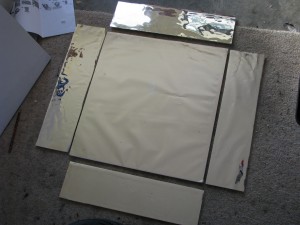 I then took some hobby wire and twisted two strands together for extra rigidity. Taped them to either side and I could adjust the angles and they would stick really well.
I then took some hobby wire and twisted two strands together for extra rigidity. Taped them to either side and I could adjust the angles and they would stick really well.
A single strand of this gauge wire would not be strong enough, I have heard of using electrical wire although I did not think it would stay in the right shape. The paint tape seems to be strong enough though.
I cut holes in the card for the bracket and the power.
The bracket attaches quite simply and then slots into the rear reflector. Below is the light with bracket before being slotted in.
Then inserted and tested. The sides hold their position quite well, the card is thick enough and the slot is tight enough that it doesn’t need to be glued or screwed into place.
Time to make some test shots!
With the light bulb in the roof only (150W)
With an indirect work light only (100W)
 Obviously the new lamp beats anything else I have in the workshop.
Obviously the new lamp beats anything else I have in the workshop.
I built a floor stand which is pretty basic. It stands 2M ish tall and holds the setup pretty well. This way I can adjust the angle and height.
 Test shot using camera on auto settings with just the ceiling light
Test shot using camera on auto settings with just the ceiling light
and with the light


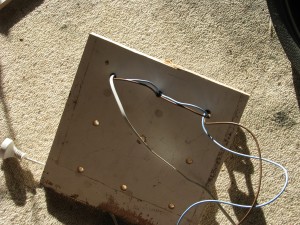


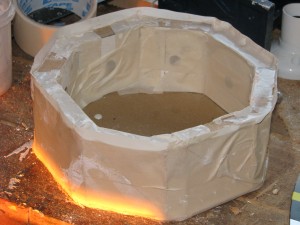


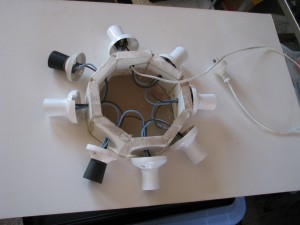

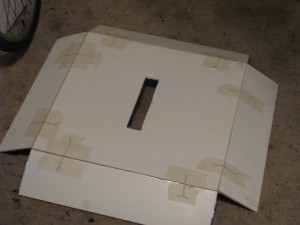



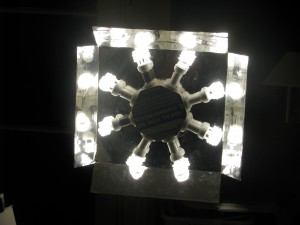
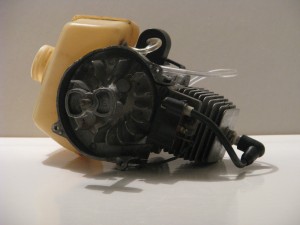



Absolutely brilliant in every sense of the word!
This is brilliant, dude. My buddy is an electrician, I think I can ask his help to make this circular film light.
Those beautiful ornaments captured in their full splendour must have made for a very satisfying project.